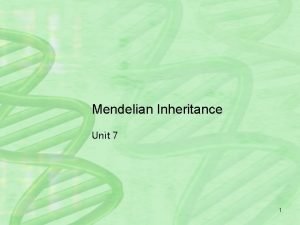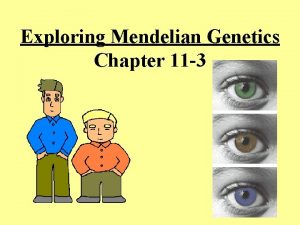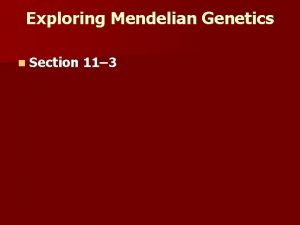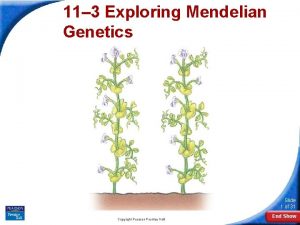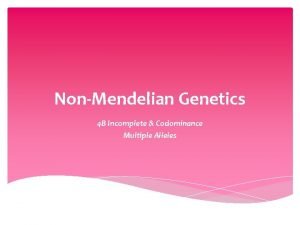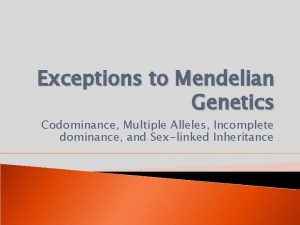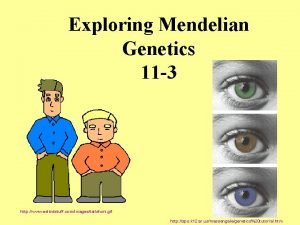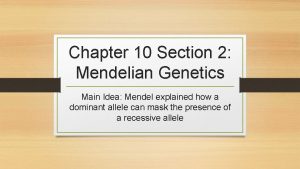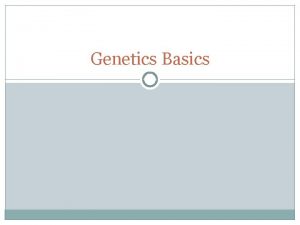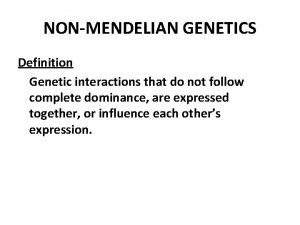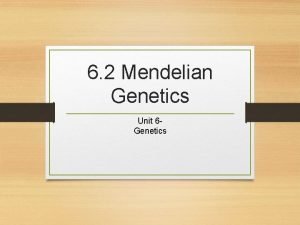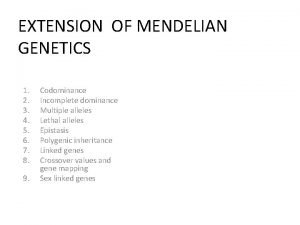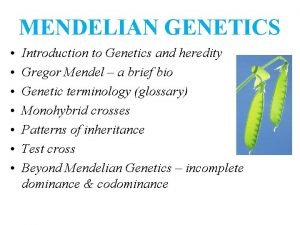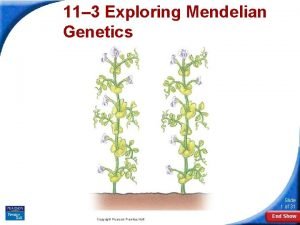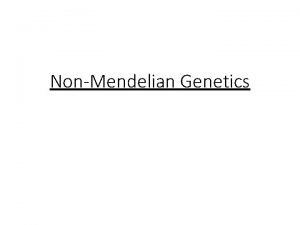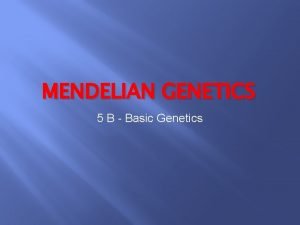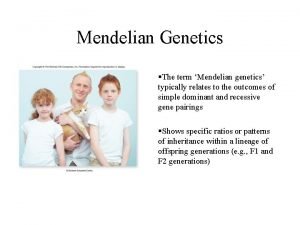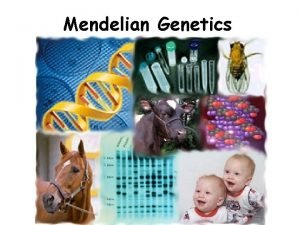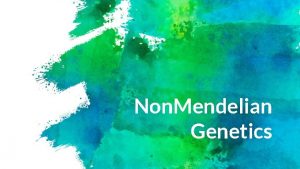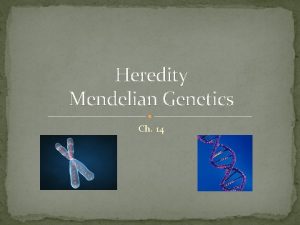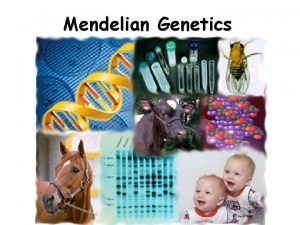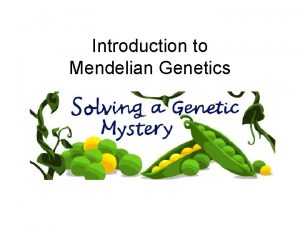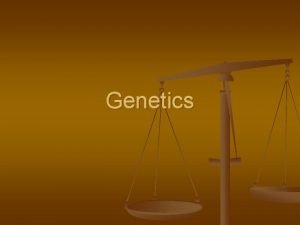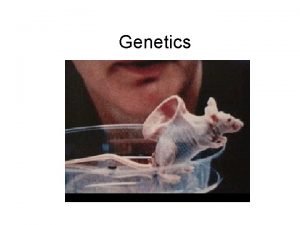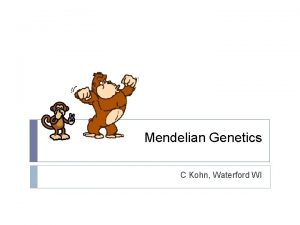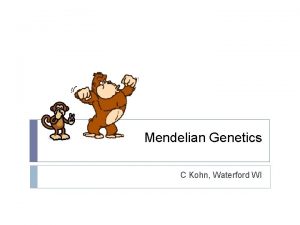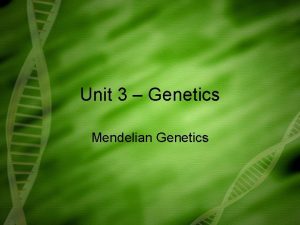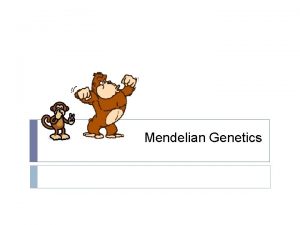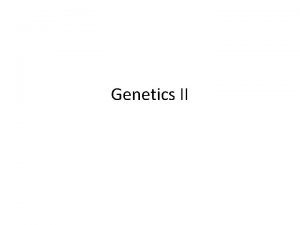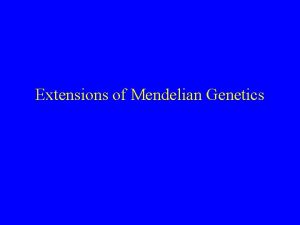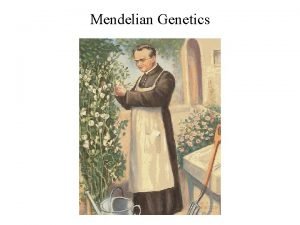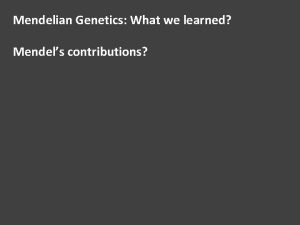Mendelian Genetics Mendelian Genetics Also referred to as
























- Slides: 24

Mendelian Genetics

Mendelian Genetics Also referred to as “transmission genetics” v Principles that describe how traits are passed from parents to offspring. v NOTE: You are responsible for the material on the interactive CD that came with your text. If you do not have the CD, you will need to make arrangements. Either share with a classmate or come to check out the extra copy I have available for 24 -hour checkout. (Hint: don’t wait until the night before the test)

Gregor Mendel (1822 -1884) Augustinian monk in what is now the Czech Republic Kept extremely accurate records of his experiments with the garden pea Restricted his studies to a very few, discrete, contrasting traits Described many of the foundational principles of trait transmission.

Definitions Monohybrid cross: A cross involving mating two individuals, each of which expresses only one of a pair of contrasting traits (e. g. round/wrinkled peas, yellow/green peas, purple/white flowers, tall/dwarf stem) Parental generation (P 1): The original parents First filial generation (F 1): Offspring resulting from parental mating. Second filial generation (F 2): Offspring resulting from the self-crossing of individuals from the F 1 generation.

Seeds: round/wrinkled yellow/green Pods: full/constricted green/yellow Flowers: violet/white Stem: axial/terminal tall/dwarf

Definitions True breeding individuals: When allowed to selffertilize, the plants produce only offspring like themselves (or, homozygous), generation after generation. (Note: self-pollination is the norm) e. g. , True-breeding tall plants only produced tall plants when self-pollinated. True breeding dwarf plants only produced dwarf offspring.

Definitions Reciprocal Crosses: Crosses were created such that the parental source of each trait was monitored and both types were represented in crosses of the parental generation. For example, ♂tall x ♀dwarf and ♂dwarf x ♀tall. Note: Mendel observed that it did not matter which P 1 plant served as the source of pollen and which served as the source for the ovum. (The traits were not sex-linked)

Outcomes Transmission genetics studies examine the outcomes of many matings. Data are expressed as ratios. For example, in one study, Mendel examined 1064 F 2 offspring and observed 787 tall plants and 277 dwarf plants, giving rise to a ratio of 2. 8 tall : 1 dwarf, or about 3: 1

Monhybrid Cross Mate tall stemmed pea plant to dwarf stem pea plant. Outcome (F 1): All tall! (The dwarf trait disappeared. ) When individuals from the F 1 were allowed to selfpollinate, the dwarf trait re-appeared in the resulting F 2 generation. Approximately 25% of the offspring were dwarf. (3: 1 ratio of tall: dwarf)

Mendel’s First Three Postulates 1. Unit factors (genes) in pairs A specific unit factor exists for each trait (tall gene and dwarf gene). Each diploid individual has two unit factors, one of which was inherited from each parent. Factors occur in pairs; therefore, three combinations are possible: two tall, two dwarf or one of each. The combination inherited determines stem height.

Mendel’s First Three Postulates 2. Dominance/Recessiveness When two unlike unit factors responsible for a single characteristic are present in a single individual, one factor is dominant to the other, which is recessive. Expression of the trait that disappeared in the F 1 but reappeared in the F 2 generation (dwarf) is under the influence of the trait that appeared regardless of generation (tall). The trait that is always apparent (tall) is dominant to the trait that is not always apparent (dwarf, recessive).

Mendel’s First Three Postulates 3. Independent Segregation During the formation of gametes, the paired unit factors separate randomly so that each gamete receives one or the other with equal likelihood. There is an equal probability that each gamete will receive either the tall unit factor or the dwarf unit factor.

Monohybrid Cross P 1 tall plants with identical tall unit factors x P 1 dwarf plants with identical dwarf unit factors. Tall is dominant to dwarf, so all F 1 plants were tall. When the gametes form in the F 1 plants, each gamete will receive either the tall gene or the dwarf gene.

Monohybrid Cross When the F 1 are allowed to randomly self-fertilize, there are four gamete pairings possible in the F 2 generation, each occurring at the same frequency: 1. tall/tall 2. tall/dwarf 3. dwarf/tall 4. dwarf/dwarf

Monohybrid Cross—(F 2 appearance) Gamete Combination Plant size v tall/tall v tall/dwarf tall v dwarf/tall v dwarf/dwarf Combinations 2 and 3 will yield tall plants because of dominance/recessiveness, so the appearance of the resulting F 2 generation is ¾ tall, ¼ dwarf.

Monohybrid Cross—Gametes Contributed The dominant unit factor is usually assigned a capital letter (D is tall) The recessive unit factor is usually assigned a small letter (d is dwarf)

Terminology v v Genotype Phenotype tall/tall (DD) (tall) tall/dwarf (Dd) (tall) dwarf/tall (d. D) (tall) dwarf/dwarf (dd) (dwarf)

Terminology Genes are unit factors Alleles are alternative forms of a single gene (e. g. tall [D] vs. dwarf [d]) Phenotype is the appearance of an individual (e. g. tall plant vs. dwarf plant) Genotype is indicated by the two unit factors (alleles) present in a given individual (DD vs Dd vs dd); the genetic makeup of an individual.

Terminology Homozygous: An individual possesses two of the same allele for a given trait (DD or dd). Heterozygous: An individual possesses two different alleles for a given trait (Dd) (The nouns are homozygote and heterozygote)

Punnett Squares Graphics that help determine the phenotype and genotype outcomes of gamete fertilization. Devised by Reginald C. Punnett

Punnett Squares F 1 Cross Dd tall x Dd tall

Punnett Square Gametes produced by F 1 parents Dd tall D Dd x tall d D d

Setting up the Punnett Square D Each gamete is arranged to show the possible contributions from a parent D d d

Setting up the Punnett Square— Fertilization D d DD tall Dd tall dd dwarf
 Difference between mendelian and non mendelian inheritance
Difference between mendelian and non mendelian inheritance Section 11-3 exploring mendelian genetics
Section 11-3 exploring mendelian genetics Chapter 7 extending mendelian genetics vocabulary practice
Chapter 7 extending mendelian genetics vocabulary practice Section 11-3 exploring mendelian genetics
Section 11-3 exploring mendelian genetics Mendel's three laws
Mendel's three laws 11-3 exploring mendelian genetics
11-3 exploring mendelian genetics Codominance and incomplete dominance
Codominance and incomplete dominance Section 11-4 meiosis answer key
Section 11-4 meiosis answer key Xnxn horse
Xnxn horse Exploring mendelian genetics
Exploring mendelian genetics Chapter 10 section 2 mendelian genetics answer key
Chapter 10 section 2 mendelian genetics answer key Chapter 10 sexual reproduction and genetics
Chapter 10 sexual reproduction and genetics Extending mendelian genetics answer key
Extending mendelian genetics answer key Chapter 7 extending mendelian genetics answer key
Chapter 7 extending mendelian genetics answer key Carrier female genotype
Carrier female genotype Pleitropy
Pleitropy Chapter 7 extending mendelian genetics
Chapter 7 extending mendelian genetics Mendel was a
Mendel was a Purebred vs hybrid
Purebred vs hybrid Pprr x pprr punnett square
Pprr x pprr punnett square Heredity concept map
Heredity concept map Chapter 7 extending mendelian genetics
Chapter 7 extending mendelian genetics Multiple alleles-
Multiple alleles- Section 11-3 exploring mendelian genetics
Section 11-3 exploring mendelian genetics Multiple alleles
Multiple alleles
